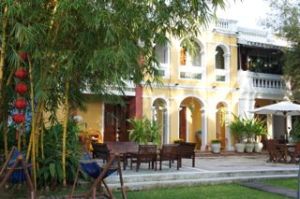 |
| Ho An Hotel French Colonial style |
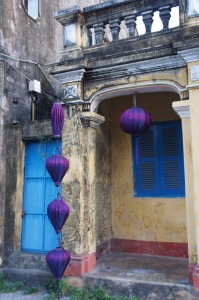 |
| Typical street decor |
In Vietnam countryside, everyone does wear those conical bamboo hats, tied under the chin with some scarf-ribbon. And often under the bamboo hat is a baseball cap or bonnet of some sort. Then there is the face mask – from something a doctor might use to “stick em up” bandanas and truly, you cannot see anyone’s face – sort of like Muslim women hide theirs, but in a different way. I think it’s a China thing, and we are near China, because everyone fears pollution and the masses of motorcycles emit plenty of carbon dioxide.
Danang, a name often associated with the Vietnam War, and now Vietnam’s fourth largest city, has become a modern urban site with a modern airport and lots of giant big name hotels under construction and golf courses designed by people like Greg Norman. Along China Beach, where our war weary marines surfed and relaxed between attacks, hotels rise like sunflowers and aim to attract tourist who are attracted to the beaches. A Miami in the bud. Yes, this is still a Communist country but that doesn’t mean private enterprise and luxury are out of the picture.
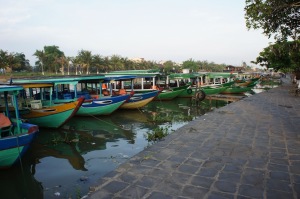 |
| Boats ready to launch |
 |
| Cassava to chew |
Our destination for three nights was Hoi An (and just to make it complicated we stay in a “boutique hotel” called Ho An.) which is a fishing village near Cat’s Tooth Mountain about 45 minutes from Danang. Hoi An is sort of a photograph of the way things were in old time fishing ports and therefore is on UNESCO’s heritage list. It was a port for the original settlers, the Sa Huynh, in the second century B.C. and the Cham merchants in in the 14th century A.D., prior to the arrival of the Vietnamese. It’s old. Very French Colonial worn out look. Lots of peeling yellow and white paint. Lots of bougainvilla, bamboo, palms, green creepers and crawlers, frangipani trees and hibiscus. Lots of lanterns made out of the same silk fabrics one can buy to have a shirt made. Every two story side by side building crammed along the narrow streets (what hogs the motorcyclists are) has a store on the bottom floor, and much to my dislike, if you even take a peak at their offerings while walking by they try to convince you to come buy. So, the plan is not to look at anything but where I am stepping, which is a good idea because there are all sorts of unwelcome goodies in the streets and you need to stay alert to the bicycles and motorcycles beeping up a storm.
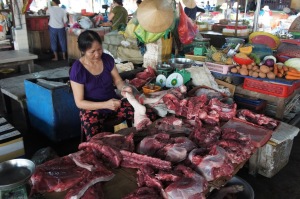 |
| Meat lady in early morn market |
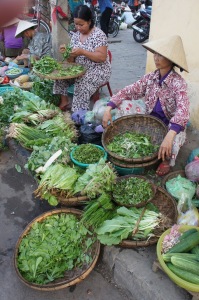 |
| Morning market greens |
Food and fish markets pack the streets near the river. We strolled through them at 6 a.m. to avoid the tourist crowds. It seems an uncomplicated daily routine of an agrarian society: outside the main streets are hectares of healthy thriving rice paddies, and fields of vegetables and ponds of lotus blossoms in bloom. Nothing seems to stir up trouble. What’s happening in the rest of the world is of little interest. It’s a good escape. But ever present in Hoi An, mind you, are conglomerates of tourist – and the bulk are American, Australian and French. Most seem young couples, at least at the “boutique” hotel I stayed at one night and the breakfast buffet offered 9 tropical fruits, every kind of cake, salad, cereal, nut and egg arrangement. Food is a big attraction, whether in an open patio under an umbrella or on the riverside where there is some semblance of a breeze.
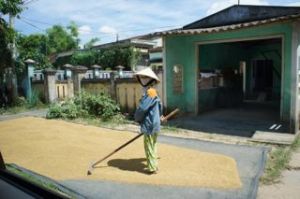 |
| Drying rice in front yard |
I cannot emphasize how hot it is. The tiny bedroom i stayed in was air-conditioned and well-lit. There was a balcony with two chairs and in the late afternoon a breeze blew through the pots of hanging vines and one could sit there and ponder if you didn’t mind the water rolling down your neck. Back into the room to dry out then walk outside the door and your body spews forth sweat like I experienced back in the early ‘60ties in Ghana. As hot as it is, I wonder how women on their mo-peds can wear thick fleece jackets, gloves, colorful tights, a bonnet-style hat on top of which sits the helmet required, then an enormous scarf wrapped around neck shoulders and face so, one hopes, she can see, but that’s all, in the noonday sun.
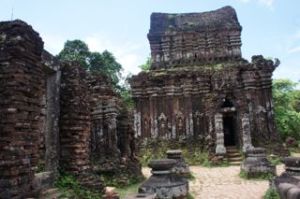 |
| My Son brick ruins |
Along the road to My Son, a rare ancient ruin built with red bricks instead of stone, and still standing since the 4th century, these same laboring women were dressed the same way while raking and drying rice spread out on wicker carpets in front of their houses. The government gives each person a quarter of a hectare to grow rice and other comestibles. It’s odd to see the rice, corn and chili peppers drying on the edges of the main road in the front yard.
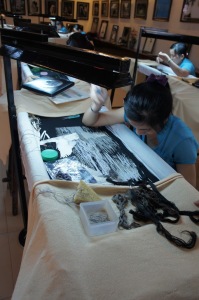 |
| The best embroidery |
My Son is the sacred remnant of the Cham civilization, much like Anghor Wat is for Cambodia culture. There are only a few Cham surviving, but at one point these seafaring people established a great Hindu civilization. My Son means Good Mountain. (Americans are referred to as “My”, also meaning beautiful, but they add they are not “my” which also means nice.) These 1500 year old ruins are deep in the jungle like one imagines jungle to be. Everything has overtaken the scattered brick remains. And efforts are being made to restore many parts of it. King Bhadravarman founded the first temple in 4th century A.D. It fell into disarray until French archeologists discovered it in 1898. It is enigmatic because it proves that plain old red bricks can survive storm and heat and neglect for centuries, including the Viet Cong using it as a base during the wars, and still stand. Beside one temple under restoration is a giant bomb crater where in 1969 the US attempted to scatter the enemy without knowing the value of the ancient temples.
In Hoi An there are opportunities to buy silk fabric and have clothes made for you and delivered in 24 hours. Also here, one can see the silkworm process including yellow and white cocoons, but most impressive was the hand embroidery – in a room full of tables, young women bend over stretched pieces of fabric with outlined subject matter and create incredible stitchery works of art through their embroidery skills – stitches that defy belief so they can copy a painting or a photograph with such detail it’s hard to tell the difference from a photograph.
 |
| Making a lantern from silk |
Also in Hoi An, I had the opportunity to visit a lantern factory and learn how to make my own lantern. I cannot say I was too swift at that. The bamboo form was already prepared and then I picked the colors I wanted to use (silk pieces) and they were glued on in sections, trimmed, then banded and a tassel was hung from the bottom. There is a hole where a light can be inserted. I laughed at myself because I was so poor at it and the young girl helping kept re-doing everything I did. Oh well.
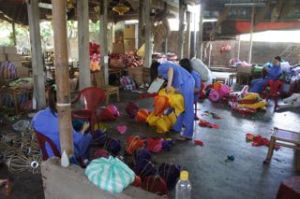 |
| Lantern factory |
Both days in this small village we lunched on fried calamari, banana flower salad or my favorite, pomelo salad with shrimp at good Vietnamese restaurants that fronted the river, where fishing boats plied their trade and other boats ferried tourists up and down the waves. Still, no matter how much iced Vietnamese coffee or limeade one consumed, the heat was overwhelming. A breeze might bumble through for a minute, but it didn’t keep you cool. At least there doesn’t seem to be insects.












I am so glad you are letting us know about the silkworms, embroidery and lantern making. It sounds like you are having a great time. Thank you so very much for sharing your adventures with us. Be safe, God Bless.
– Scottie